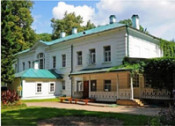
State museum-estate of Leo N. Tolstoy “Yasnaya Polyana” was founded
“Without my “Yasnaya Polyana” I can hardly imagine Russia and my attitude to it. Were there no “Yasnaya Polyana”, I might see general laws, vital for my Motherland, more clearly, but I would not love it so desperately”.
Leo N. Tolstoy
On June 10 1921 by the resolution of the All-Russian Central Executive Committee the estate of Leo Nikolaevich Tolstoy in the “Yasnaya Polyana” (“Clear Glade”) received a status of a museum.
“Yasnaya Polyana” is an estate in Shchekinsky district, Tula oblast (located 14 km south-west away from Tula), which was established in 17th c. and belonged firstly to Kartsevy family, later to Volkhonsky and Tolstoy families. On August 28 (September 9) 1828 an outstanding Russian writer and philosopher, Leo Nikolaevich Tolstoy, was born in the estate, where he spent the most part of his life and where he was buried.
In October 1910 Leo Tolstoy secretly left “Yasnaya Polyana” following his decision to spend last years in accordance with his views, but on his way caught pneumonia and died on November 7 (20). On November 10 (23) 1910 the writer was buried in “Yasnaya Polyana”, on the ravine’s edge in the forest.
In 1911 Sophia Andreevna Tolstaya — the writer’s widow — turned to Nicholas II twice with a request to take “Yasnaya Polyana” under the state’s protection, but was met with a refusal. She was granted a pension, which was partly used to cover estate’s maintenance costs.
Eight years later, in May 1919, People’s Commissariat of Education gave the writer’s daughter, Alexandra Lvovna Tolstaya, a safe certificate for the estate, which stressed an exceptional cultural value of articles, located in its territory. The estate was declared a national domain and taken under the state’s protection. On June 10 1921 “Yasnaya Polyana” achieved a status of a museum.
During the Great Patriotic War museum’s exhibits were evacuated to Tomsk. “Yasnaya Polyana” was occupied for 45 days. During retreat the Nazis set fire to the Tolstoy’s house, but fortunately the fire was put up. In December 1941, immediately after the liberation, reconstruction works were launched; the first stage was completed already by May 1942 and the museum welcomed its visitors. In May 1945 evacuated values were returned to “Yasnaya Polyana”. The museum-estate’s reconstruction continued up to middle ’50s. By that time several buildings, an apple orchard, destroyed by frost during the war, and the mansion were revived.
In 1986 the museum-estate “Yasnaya Polyana” received a status of the State Memorial and Nature Preserve; in 1993 — a status of a cultural object of primary importance. In 1994 one of the descendants of Leo N. Tolstoy, his great-great-grandson Vladimir I. Tolstoy, got the position of the museum’s director.
The museum-estate of L. N. Tolstoy “Yasnaya Polyana” covers the area of 412 hectares of the reserve. The museum’s exposition includes the writer’s mansion, literature museum, the library, which holds 22,000, the mansion of N. S. Volkhonsky — Leo Tolstoy’s grandfather, the tomb of Tolstoy, the old linden park, ponds, forests, meadows, ploughed fields and gardens, as well as dozens of memorials and the richest holdings of invaluable relics, which shed light on the life of the writer. The furniture at the museum of Leo N. Tolstoy has been restored exactly how it was left by the writer in 1910.
Today “Yasnaya Polyana” is a major Memorial and Nature Preserve of the world significance.
Lit.: 80 лет музею-усадьбе Льва Толстого «Ясная Поляна» // Воскресение. 2001. № 4; Никитина Н. А. Ясная Поляна: Путеводитель по заповеднику [Л. Н. Толстого]. Тула, 1989.
Based on the Presidential Library’s materials:
Айвазов И. Г. Граф Лев Толстой. Петроград, 1914;
Иванов-Разумник Р. В. Лев Толстой. Т. 4. СПб., 1912;
Основан музей Льва Николаевича Толстого в Москве // День в истории. 10 января 1912 г.;
Последние дни Льва Николаевича Толстого. СПб., 1910;
Розанов В. В. Л. Н. Толстой и Русская Церковь. СПб., 1912;
Толстой Л. Н. Об отношении к государству: Три письма. Лондон, 1897;
Тульская губерния. Ясная Поляна // Территория России: коллекция;

